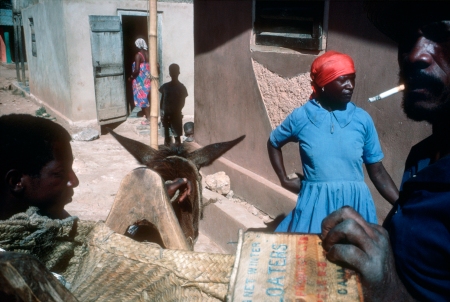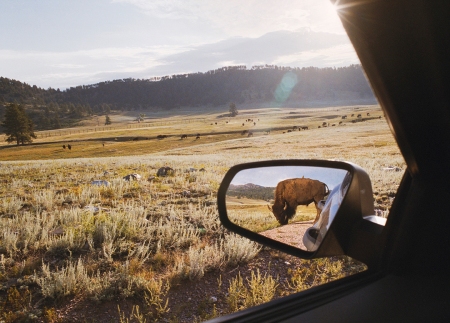Photography –– or at least straight, unmanipulated photography –– seems unique amongst art forms in the level to which chance or accident plays a role in the creative process. Photographers are at the mercy of the world and the world only gives them so much. To paraphrase the classic example, mentioned by CHARLES HARBUTT in his afterword to his book, Travelog: A photographer working in a white seamless room has only a few creative options: a white photograph, a gray photograph, a black photograph, and perhaps a variety of self portraits. A painter, on the other hand, working in that same white room, is only limited in his paintings by his imagination: He can paint the sea, the mountains, cityscapes, portraits, and more. Photography involves a different process than most of the other arts.
What this means is that often another kind of collaboration with the world emerges with photography, one that may involve accident, serendipity, or chance. Technical mistakes –– or what the photographer initially thinks of as mistakes –– can become revelatory. These may include the surprise of a blur, of underexposure or overexposure, of the lopped-off head.
So, for February’s FOTOFORUM, we asked a variety photographers –– including JEFF JACOBSON, whose photograph of his father and son graces the cover of his first book, My Fellow Americans –– to talk about one of their photographs that they perceived as a FORTUNATE MISTAKE or LUCKY ACCIDENT.––Alex Webb and Rebecca Norris Webb

Jeff Jacobson, Harold & Henry, Naples, Florida, 1981
My father and my then two-year-old son were playing in the warm Gulf of Mexico waters at sunset. The sky was ablaze. I charged into the surf, holding my strobe high over my head to avoid unpleasant electrical repercussions, squeezed off two frames, and returned to the beach. When I looked at my strobe, I noticed it was on the wrong setting, too strong. I decided right then and there, long before I had seen the picture, that it would be overexposed, and therefore, no good.
A couple weeks later I was editing on my light table and showed the picture to my friend Richard Sandler. I told him that it was too bad that it was overexposed because it could have been a good picture. “Schmuck!”, Richard delicately said, “that’s what makes the picture. Look how the baby glows.” It was an early lesson in non-attachment to the experience of exposure, the moment is not the picture. It helped me learn to take as long as possible between exposing a photograph and editing it. In the digital world, this is a problem. But that’s another rant.––Jeff Jacobson
Jeff’s new website

Dimitri Mellos, Central Park, 2009
I shot this picture last year in Central Park. I love snow and I ventured out in the midst of a blizzard, not even waiting for the snowfall to stop, the sooner to enjoy the first snow of the year. I think I had been photographing the previous evening, and I’d forgotton to change the shutter setting on my camera. I ended up taking several pictures at a very slow shutter speed before realizing and correcting my “mistake.” Nevertheless, when I got home and edited my photos, it dawned on me that the pictures taken at a slow shutter speed, counterintuitive as that was in the blinding whiteness of the snowstorm, were in fact more interesting than the others, because they managed to capture something of the chaotic movement of the wind and the falling snow, and the subjective sense of being caught in the midst of all this. I realized that sometimes the “moment: can be better captured through an exposure that is not so instantaneous and momentary.––Dimitri Mellos
Dimitri’s website

Torkil Faero, Telma, Paros, Greece, 2008
This is an image of Tonje’s and my daughter Telma, taken on Paros, Greece in 2008. When I later developed the pictures, I saw that the whole roll had this strange effect. I had to think back to our Greek holiday with our catamaran S/Y Kairos to solve the mystery. We had been on a day trip and returned late to our boat and the quay was totally dark. Eager to get to bed, our son Torbjørn ran and slipped off the boarding plank and into the pitch black sea. I had to wait until he resurfaced before jumping in to get him. I was terrified. My son was screaming. Amid all the turmoil, I’d forgotten I’d left this roll of film in my pocket, and the salty water created this special effect. It ruined most of the pictures, but, on this one of Telma, it seemed somehow to enhance the moment.
As we will continue to sail our boat, I might try this again someday, hopefully without Torbjørn underwater.––Torkil Faero
Torkil’s website

Olga Kravets, from the project, "Primorsk: The Sunken Soviet City"
This December, I finally finished the work on my project “Primorsk: The Sunken Soviet City.” Most of it was shot with a Holga, a camera that too often lets light leak onto one’s film, ruining many a promising photograph. This was initially extremely frustrating to me, until I realized that some light leak–– like with the above photograph of the torn world map in an abandoned school –– emphasizes the “underexposed” and mysterious atmosphere of the place. ––Olga Kravets
Olga’s website

Animesh Ray, "The Widow," Varanasi, India, 2009
I took this last month while on a 24-hour trip to Varanasi, a city that I had last visited as an eight-year-old in 1963. I mostly shoot with black and white film, but this time I wished to tame my new d300—a monstrosity compared to the trusted M6. I also had in mind Alex and Rebecca’s vivid color from their Seattle workshop, and I thought this was a good occasion to seriously attempt color.
It was quite dark early in the morning in dingy Varanasi lanes. I was shooting with my M6 but getting nowhere because most of the time I was keen on avoiding the excreta left by dogs and cows, when I emerged on to the riverside into extraordinary lights. Nearly instantaneously I saw this widow against the river, thought of Styx and all that, and reached for the d300. I only had one lens, a manual 28mm f/2 Nikkor, the body set at 1600ASA at ~1/15 sec, the longest exposure I can handhold this lens. I usually keep the lens at hyperfocal distance by feel. But having been shooting with M6, I had momentarily forgotten that Nikkors turn the other way relative to Summicrons, and so managed to set the focal plane a lot closer. I took a few frames, with the scene being way too dark to discern through the viewfinder the problem with focus, and only later when I peered into the back I realized my mistake. Dang, I thought, and nearly deleted the soft frames!
A fortunate mistake…––Animesh Ray
Click here see more of Animesh’s photographs, including others taken in Varanasi.

Rajiv Kapoor, West Bank, Palestine, 2009
Everywhere I wandered in the West Bank, I noticed passion, passion for politics, for statehood, for soccer, for food, for religion, and the list goes on. I decided to photograph a soccer match in a stadium. Originally I intended to capture the facial expressions of the audience when everyone was standing, a moment that I thought would add to the intensity of the scene. At the moment I clicked the shutter, however, most people sat down and I thought I’d missed the shot. Later, when I looked at the image, I realized the intensity was there in a way I hadn’t imagined, and made for a stronger image.––Rajiv Kapoor
Rajiv’s website

John Masters, Italy, 1992
I was traveling in Italy in 1992. I had just begun using a second hand Canon AE-1. The film was Kodak Tri-X 400. I cannot recall the f-stop or shutter speed but I do remember walking through an arch into the plaza and seeing the boy running after the pigeons, causing them to rise up. I took to picture as fast as I could. For a long time I bemoaned its graininess, blur and off-centered framing but I loved the look on his face and the movement of his feet. This is one of my favorite images and reminds me I should always retain my “beginners eye.“––John Masters
John’s website








